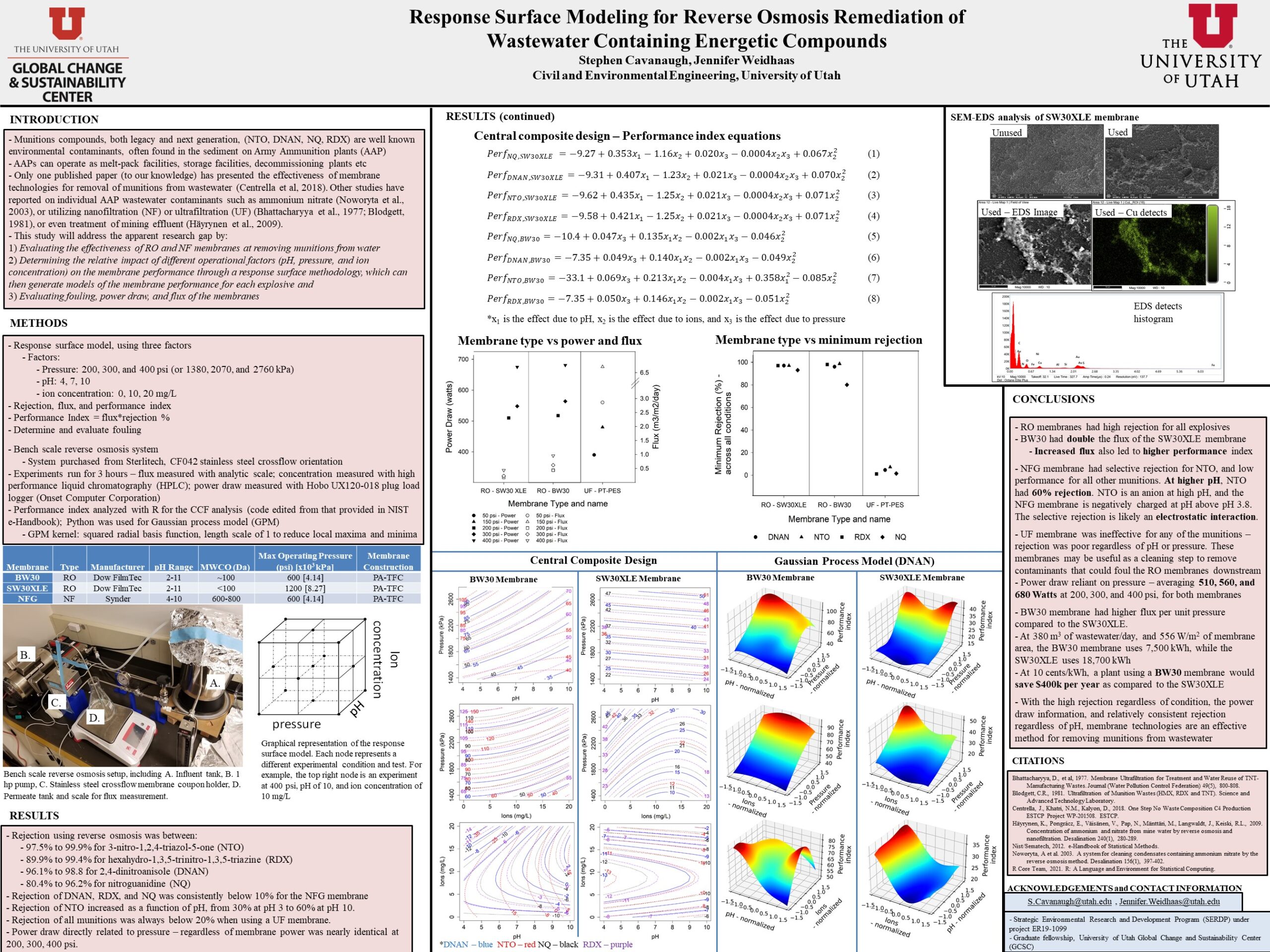Response Surface Modeling for Reverse Osmosis Remediation of Wastewater Containing Energetic Compounds
–Stephen Cavanaugh, Jennifer Weidhaas
[bs_collapse id=”collapse_bb86-afd7″]
[bs_citem title=”Bio” id=”citem_e610-6c22″ parent=”collapse_bb86-afd7″]
I am a PhD candidate in the Civil and Environmental Engineering department at the University of Utah. My research includes estimating mass transfer coefficients using high performance liquid chromatography and modeling membrane filtration systems for removing munitions compounds as well as ionic liquids. I have plans to remain in academia researching wastewater treatment and wastewater reuse when I graduate.
[/bs_citem]
[bs_citem title=”Abstract” id=”citem_eca8-96a7″ parent=”collapse_bb86-afd7″]
Traditional and next-generation munitions compounds (NTO, DNAN, NQ, RDX) pose monetary and ecological hazards to Army Ammunition Plants that work with them. This poster will present the results of a response surface model used to evaluate reverse osmosis (RO) – and rejection for nanofiltration (NF) and ultrafiltration (UF) – membranes for treatment of wastewater containing these four munitions. The response surface model consists of three factors – pH, pressure, and ion concentration. Rejection using reverse osmosis was between 97.5% to 99.9% for 3-nitro-1,2,4-triazol-5-one (NTO), 89.9% to 99.4% for hexahydro-1,3,5-trinitro-1,3,5-triazine (RDX), 96.1% to 98.8 for 2,4-dinitroanisole (DNAN), and 80.4% to 96.2% for nitroguanidine (NQ). Rejection of DNAN, RDX, and NQ was consistently below 10% for the NF membrane, while rejection of NTO increased as a function of pH, from 30% at pH 3 to 60% at pH 10. Rejection of all munitions was always below 20% when using a UF membrane.
[/bs_citem]
[bs_citem title=”Narrative” id=”citem_780c-0f71″ parent=”collapse_bb86-afd7″]
Traditional and next-generation munitions compounds (NTO, DNAN, NQ, RDX) pose monetary and ecological hazards to Army Ammunition Plants that work with them. This poster will present the results of a response surface model used to evaluate reverse osmosis (RO) – and rejection for nanofiltration (NF) and ultrafiltration (UF) – membranes for treatment of wastewater containing these four munitions. The response surface model consists of three factors – pH, pressure, and ion concentration. Rejection using reverse osmosis was between 97.5% to 99.9% for 3-nitro-1,2,4-triazol-5-one (NTO), 89.9% to 99.4% for hexahydro-1,3,5-trinitro-1,3,5-triazine (RDX), 96.1% to 98.8 for 2,4-dinitroanisole (DNAN), and 80.4% to 96.2% for nitroguanidine (NQ). Rejection of DNAN, RDX, and NQ was consistently below 10% for the NF membrane, while rejection of NTO increased as a function of pH, from 30% at pH 3 to 60% at pH 10. Rejection of all munitions was always below 20% when using a UF membrane.
[/bs_citem]
[/bs_collapse]

